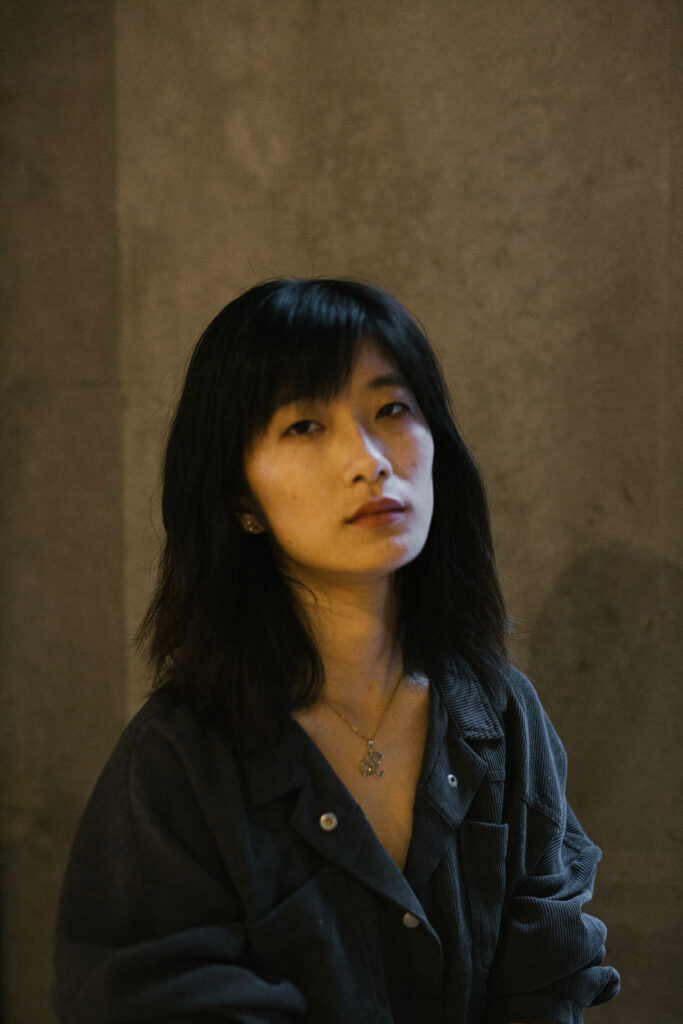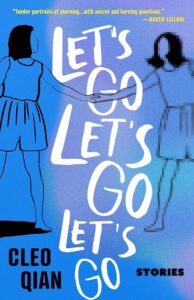
Let’s Go Let’s Go Let’s Go (Tin House, 2023) by Cleo Qian is jam-packed with female and queer Asian and Asian American narrators stumbling through youthful escapades across Los Angeles, Asia, and New York. The stories are unhurried with often surprising surreal elements and vivid prose reminiscent of a well-crafted Japanese Manga comic. In “The Girl with the Double Eyelids,” the narrator—post double eyelid surgery—finds herself with an unexpected truth-seeing symptom. In “Monitor World,” a girl gets ensconced in a strange romance with an older man she meets online. In the titular story, “Let’s Go Let’s Go Let’s Go,” a group of former classmates join a mysterious phoneless retreat in the mountains of Japan and are encouraged to make art and destroy it, only if they agree to be watched by cameras 24/7. Technology plays an essential yet sinister role in Qian’s stories, perhaps as a villain or maybe just a representation of the landscape of our time.
Qian and I Zoomed a week before her short story collection debuted. We talked about her journey to publication, growing up in Southern California, the influence of visual art on her writing, Korean fried chicken, and the Asian writers that inspire her work.
Diana Ruzova: You’re one week away from your debut short story collection! How are you feeling?
Cleo Qian: I’m feeling fortunate that the debut is the same month as a close friend of mine, Kyle Dillon Hertz. He and I have talked about our lead up to publication over the last year or so, and both of us are feeling kind of like, finally all this hype will be over. It’s been a little exhausting.
I can imagine. Let’s Go Let’s Go Let’s Go features several Asian and Asian American female narrators. Why is it important to tell these particularly female, queer, Asian and Asian American stories?
I feel like it’s up to the reader to decide what’s important to them or not. I feel like there’s so many queer Asian women, like so many. But you don’t see much of that in literature. But I think that more and more of us are writing and publishing now. It’s a game changer and it’s just awesome.
That is awesome! I would love to know a little bit about your writing journey. How did you get here? When did the spark for this book project ignite? What was the writing process like for you?
I wasn’t setting out to write a short story collection. I went to an MFA program at NYU and there was a lot of pressure to write a novel. I was trying and trying to write a novel for five years and it wasn’t really going that well. On the side, I was writing all these short stories to escape the pressure of writing a novel. Eventually, I had a lot of short stories, and I was like, Oh, this is enough for a collection. I finished polishing them over COVID. And then I sent them out to agents. I told them I was also working on a novel. A lot of the agents were like, Well, the stories are pretty good, but we really want a novel, so no one signed with me. When I finally finished the novel draft a year later, I didn’t really like it. I didn’t want to publish it. Even if I edited it for a long time, I didn’t think it was going to get any better. I really wanted to move on. By then I had revised the short story collection and changed the themes. It felt a little bit more adult. I went back to a lot of agents, and they were still like, No. Then Tin House had this open submission period where you don’t need an agent . . .
It sounds like your journey was a lot of stops and starts, but you finally found your way.
Most of my cohort had agents. I got the editor and publishing contract [from Tin House] on my own. I got an agent afterwards to negotiate the business part. My agent has been a really good advocate for me, and in the end, this book worked out. But I do feel like my publishing journey was a lot more like an indie poet’s.
In the story “Monitor World,” the narrator becomes involved with an older man she meets in an online game. Other stories feature camgirls, text messages, a dating app, Instagram, cameras watching one’s every move. Technology plays a sinister role in Let’s Go Let’s Go Let’s Go. Is technology a kind of villain in your stories?

I think sometimes, people use technology for escapism or to play out different hopes and fantasies, to explore different parts of themselves. And it is a double-edged sword. For the last several years I’ve been really interested in digital technology and how it influences our lives. I think it’s interesting to think about why we feel so compelled to escape to the internet. What lack do we have in our physical, grounded life that is making us look for that escapism? I also think that the questions of why we use technology, how we use it, and how it impacts our identity are not new.
You play with magical realism and the surreal. There are spirits, and alchemy, and tattoo-like visions after a double-lid surgery, to name a few. What is your relationship with the supernatural? Does tapping into the mystical world help fuel creativity when writing fiction?
I’m not good at sticking to realism. I grew up with a lot of anime and manga, where things are very fluid. xxxHolic by CLAMP and Natsume Yuujinchou by Yuki Midorikawa were very influential since the supernatural brushes right up against real life.
There was one scene in your book where a single tear fell down someone’s cheek, and I remember thinking to myself, Wow, this feels like I’m in an anime. It was really effective.
There are also references to performance art throughout. The animated short in “Monitor World” called “CHECK THIS BOX TO VERIFY YOU ARE NOT A ROBOT,” and of course the performances at the culty retreat run by the Anti-Civilization Committee in the title story, “Let’s Go Let’s Go Let’s Go.” There is a reference to the infamous performance artist Marina Abramovic. I’m curious if you have a relationship with performance art and how that art form informs your writing?
I don’t personally have any relationship with performance art. I can’t see myself doing it. But I really like visual art because a lot of it is so concept based. There’s no pressure to execute a narrative, unlike in fiction. The title story was inspired by a piece of visual art: the 2019 Japan Society exhibit, Radicalism in the Wilderness: Japanese Artists in the Global 1960s, particularly the conceptual artist Yutaka Matsuzawa and his piece Banner of Vanishing (1966), a long pink silk screen banner that read: “Humans, Let’s Vanish, Let’s Go, Let’s Go, Gate, Gate-Anti-Civilization Committee.”
I know that you’re a part of the art collective Egocircus and I wasn’t sure if that included some performance aspects.
I think some people in that group like to perform, like my friend Jinjin Xu.
In the title story, “Let’s Go Let’s Go Let’s Go,” a group of former classmates join a mysterious phoneless retreat in the mountains of Japan. The retreat is about “anti-materialism” and “the rule is: Everything we make has to disappear.” The main characters draw on sand with calligraphy brushes and call the piece “Vanishing Sand.” They throw, fire, and glaze pottery, and then smash their finished pieces against the wall. There is something so powerful and transgressive about these performances, and yet the characters are not fully experiencing free expression because they are—the catch—always being filmed by dozens of cameras. This reminds me of the “We Live in Public” project by the once millionaire and first reality-TV star, Josh Harris. What inspired this story? Is another title for this story, “let go let go let go”?
I think that the main character in that story needs an outlet to help her let go. And finding Lily and the Anti-Civilization Committee helps her loosen up a little bit and just make things without thinking too much because they are all going to be destroyed. I was inspired by “We Live in Public“! I was curious about what it’s like to be surveilled. What’s it like to feel monitored? I was inspired by the nihilist avant garde artist that I mentioned earlier, Yutaka Matsuzawa. There’s also this 1970s performance where artists painted on snow and watched the paint leak into the gutter as the snow melted . . .
I’m also from California! Los Angeles, actually. LA and its food scene, specifically Korean Fried Chicken surrounded by refreshing fruit, makes an appearance in the first story, “Chicken. Film. Youth, ” recently excerpted in The Sun. What inspires you most about Southern California?
I was born in Pasadena and grew up in San Diego. But I have friends in LA, so I would go and see them a lot. The Korean fried chicken with fresh fruit from “Chicken. Film. Youth, ” is actually based on a real restaurant called Gol Tong.
Growing up in Southern California, I was around a lot of Asian people, both in LA and San Diego. I did not grow up feeling like the only Asian person around a ton of white people. And so, I think that influenced how I write about being Asian. But the model minority communities have different pressures. There was a lot of achievement pressure, which inspired the story, “The Virtuoso.” I also just really like the natural landscape of California. The driving. I drove a lot and it was relaxing. The climate. The roads. The spaciousness. I think those are things that influenced me.
Yes! So much driving.
Driving is very private.
It is! Your work feels both singular and familiar. Was there a writer or stack of writers that inspired Let’s Go Let’s Go Let’s Go?
I love Kokoro by Natsume Soseki, Yoko Ogawa, Hiroko Oyamada, Mariana Enriquez, Yiyun Li, Han Kang, and Jorge Luis Borges.
What do you hope readers walk away with after reading your debut?
I hope they enjoy it. I hope that they have a fun time reading it. And I hope that maybe they feel some emotional catharsis. When I write, I really do try to go deep into the emotions of the characters and emphasize building interiority for those messy emotions and difficult feelings.
Diana Ruzova is a journalist and essayist based in Los Angeles. She has an MFA in literature and creative nonfiction from the Bennington Writing Seminars. Her writing has appeared in Peach Magazine, LAist, The Cut, Los Angeles Times, Oprah Daily, and elsewhere. Diana’s work centers around the contemporary immigrant experience.
This post may contain affiliate links.







